Hermosa Planta de Helecho - Cuidados, Necesidades, Características y Tipos de Helecho
El helecho es una de las plantas de interior más populares. Aunque hay varios cientos de especies de helechos de distintas necesidades, las más comunes son bastante fáciles de cultivar y no necesitan ningún tratamiento especial. ¿Se pregunta si un helecho es una buena opción para su casa o apartamento? Es una planta tan universal que se adapta perfectamente a cualquier interior, independientemente de su estilo. Pero es una opción especialmente buena para los estilos boho y de jungla urbana.
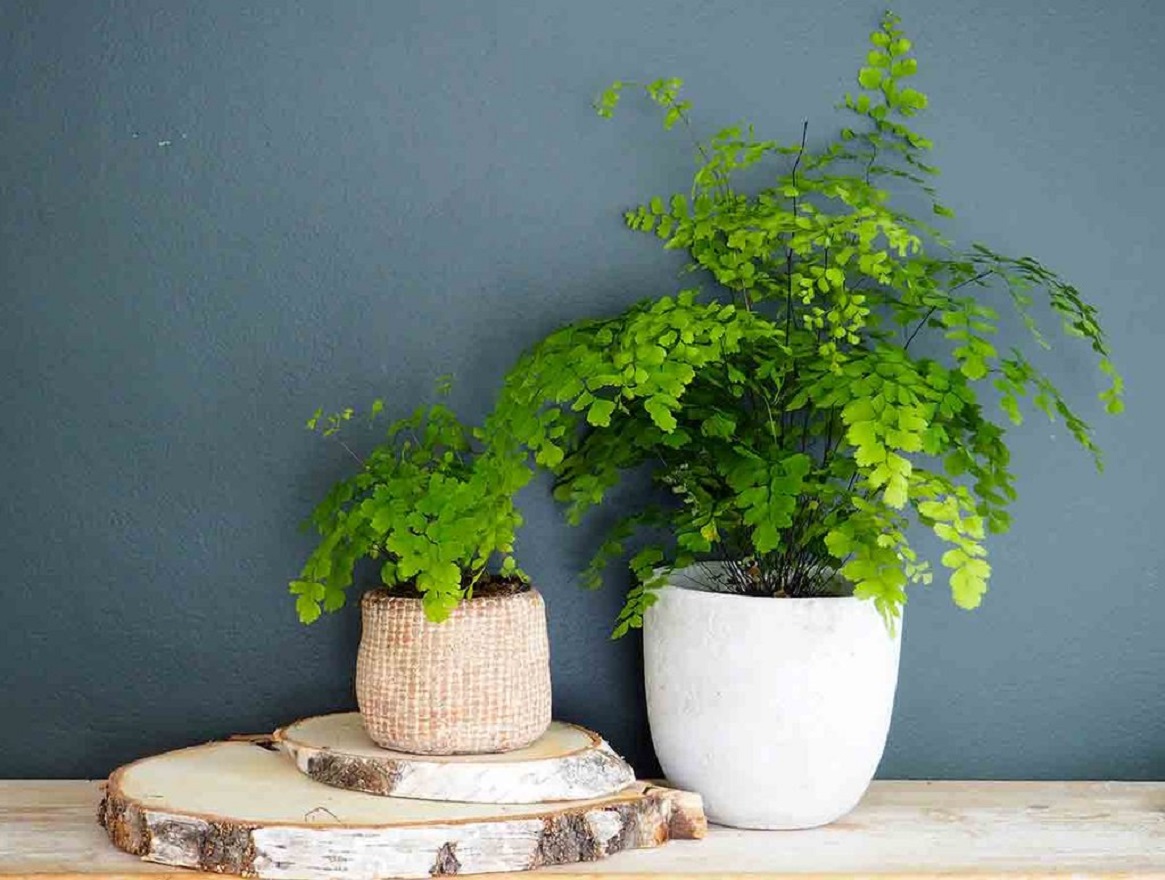
¿Cuáles son los tipos de helechos más populares?
El mercado ofrece unos cuantos cientos de tipos de helechos. Por ello, no es fácil elegir uno, sobre todo porque muchos de ellos tienen un aspecto muy diferente. Sin embargo, algunas especies son más populares que otras y pueden encontrarse en muchos hogares. ¿De qué plantas se trata?
- Helecho espada (Nephrolepis exaltata) - planta de helecho que probablemente sea bien conocida por las generaciones más antiguas. Tiene unas hojas características y plumosas. Este tipo de helecho es bastante duradero, y su intenso color asombra a todo el mundo.
- Helecho pata de conejo (Davallia tyermanii) - hermosa planta de helecho con hojas inusuales originaria de las Islas Canarias. Esta planta no crece en altura, pero puede extenderse rápidamente hacia los lados. Es una opción perfecta para aquellos a los que les gustan las plantas de interior no estándar.
- El helecho de pelo de doncella del sur (Adiantum capillus-veneris) - una planta de helecho bastante inusual y característica por su interesante aspecto. Las frondas no se parecen a las típicas hojas de los helechos: son pequeñas y parecen abanicos de mano.
- Helecho botón (Pellaea rotundifolia) - un helecho con hojas redondas que crecen en largas ramitas. Tiene un característico color oscuro saturado. También es una de las plantas más fáciles de cultivar.
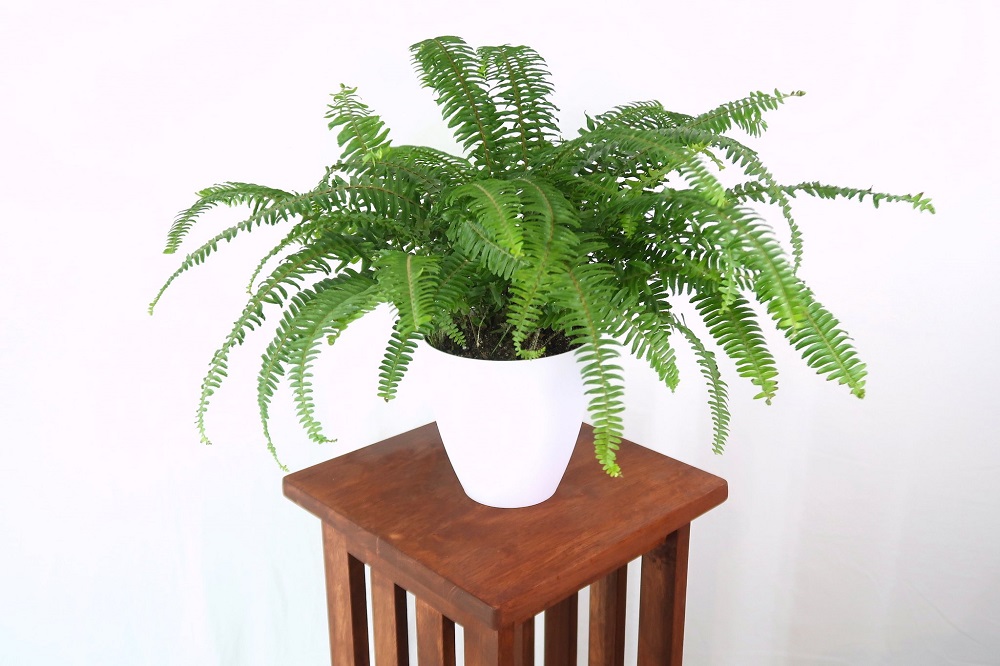



¿Tienen las plantas de helecho algún beneficio para la salud humana?
Pocas personas saben que las distintas variedades de helechos, al igual que los lirios de la paz, son perfectos purificadores del aire. Las hojas de los helechos son especialmente valiosas: funcionan como filtros de aire. Curiosamente, los helechos pueden eliminar no sólo el dióxido de oxígeno del interior, sino también otros elementos nocivos. Se trata, por ejemplo, de las partículas de los productos que se utilizan para pintar las paredes.
La planta de helecho también debería cultivarse en cualquier hogar con muchos dispositivos electrónicos como ordenadores, televisores, proyectores y otros. ¿Por qué? Neutralizan perfectamente la radiación producida por tales equipos.
Polipodio común: ¿dónde se puede poner?
El polipodio común es una variedad de helecho que puede colocarse prácticamente en cualquier interior de la casa. Queda perfecto en el salón, así como en el pasillo. También es una gran planta de dormitorio, sobre todo por sus propiedades para purificar el aire.
Recuerda que las plantas de helecho (o cualquier otra planta viva) no pueden colocarse junto a los radiadores. Un calor demasiado intenso no es bueno para ellas, ya que las seca.
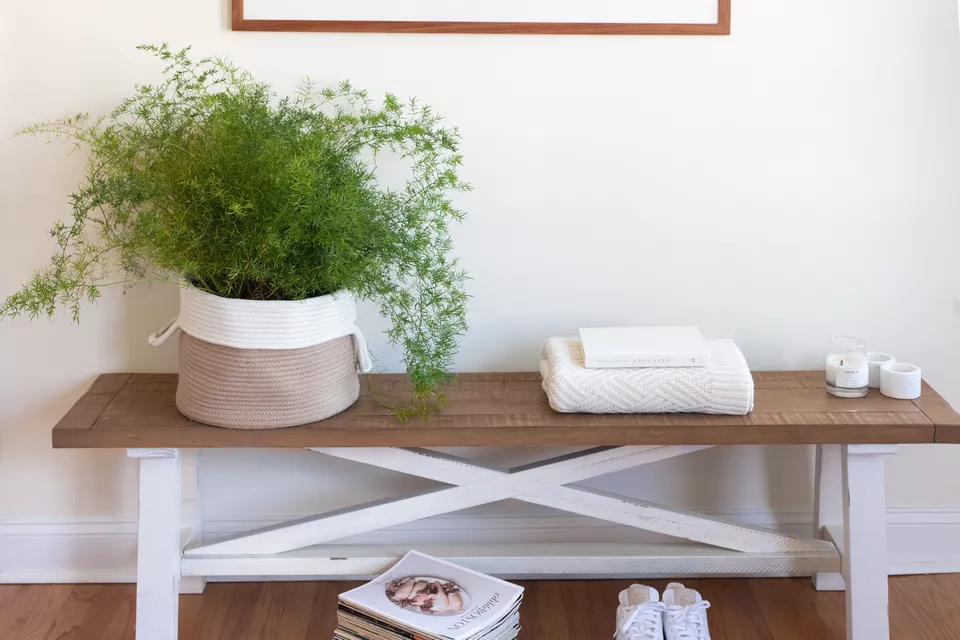
Planta de helecho: ¿cuáles son sus necesidades?
Aunque el helecho como planta de interior no necesita ninguna condición especial para crecer, hay ciertas reglas básicas que se deben seguir.
La elección del lugar adecuado es la cuestión básica. No debe ser demasiado soleado, ni completamente sombreado. La media sombra con acceso a la luz solar es la mejor opción.
El suelo para las plantas de helecho debe ser fértil y ácido. Puedes mezclar la clásica tierra para macetas con humus y turba: proporcionarán unas condiciones de crecimiento perfectas para tu helecho. Si no tienes mucha experiencia, también puedes comprar una mezcla de tierra especial para helechos en una tienda de jardinería.
La tierra para un helecho debe estar húmeda pero no mojada. Mucha gente confunde estos dos términos y, como resultado, las plantas mueren. Si vas a trasplantar tu planta de helecho por ti mismo, recuerda que es recomendable poner un poco de grava en el fondo de la maceta: retendrá perfectamente la humedad.
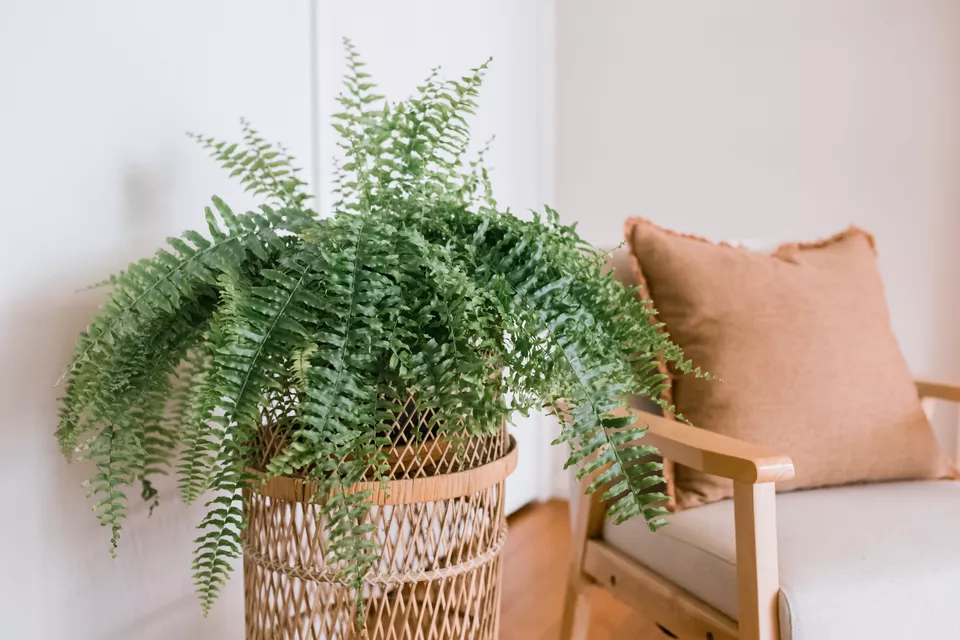
¿Necesita el helecho ser abonado?
Las plantas de helecho no tienen muchos requisitos, lo que también se refiere a la fertilización. Dependiendo de las condiciones de su casa, alimentar su planta una vez al mes será suficiente. En verano, cuando ventile los interiores con frecuencia, puede intensificar el uso de fertilizantes y alimentar la planta una vez cada dos semanas.
Los helechos prefieren los fertilizantes líquidos, especialmente las variedades organominerales. El producto debe contener potasio, nitrógeno y fósforo. De este modo, no sólo nutren la planta, sino que también regeneran el suelo.
¿Cómo trasplantar una planta de helecho?
A la mayoría de las variedades de helechos no les gusta el trasplante. Por ello, los expertos aconsejan no hacerlo con demasiada frecuencia. ¿Cuál es el riesgo? Las plantas de helecho crecen mucho más despacio después del trasplante y pueden ser más propensas a diversas enfermedades.
Si decide trasplantar su helecho, hágalo en primavera. Póngalo en una maceta de cerámica, es mucho mejor para este propósito.
Para que el proceso de trasplante de helechos sea más rápido, asegúrese de regar bien la planta de antemano. Así será más fácil sacarla de la maceta sin dañar las raíces.

¿Cómo se propagan las plantas de helecho?
Dependiendo de los tipos de helecho que cultives en tu casa, hay tres métodos para su propagación. Cada uno de ellos es bastante fácil de hacer, por lo que no deberías encontrar ningún problema.
Muchas variedades de helechos crecen con brotes separados. Tras un examen minucioso, deberías fijarte en esas partes concretas. Si tiene una especie de helecho de este tipo, puede propagarla simplemente separando los brotes de la planta madre y plantándolos en pequeñas macetas.
La gran mayoría de las plantas de helecho se pueden propagar mientras se trasplantan. Sólo tiene que dividir la planta. Con este método, puede estar seguro de que la plántula arraigará correctamente.
Algunos tipos de helecho son más fáciles de “mantener”. ¿Qué significa esto? Basta con cortar una ramita, enraizarla y plantarla en una maceta. Es la forma más rápida, aunque necesita un buen producto para maximizar el crecimiento de la joven planta.

Helecho regado en exceso: ¿se puede salvar?
A las plantas de helecho les gusta la humedad y el riego frecuente, al menos una vez a la semana. ¿Cómo se sabe que la planta ha sido regada en exceso? ¿Lo señala de alguna manera? Sí. Pero puede ser muy confuso. Los helechos reaccionan de la misma manera ante un suelo demasiado seco o demasiado húmedo. ¿Qué ocurre entonces? Las hojas del helecho se vuelven marrones o amarillas, y toda la planta no tiene muy buen aspecto. En tal caso, pregúntese cómo ha tratado al helecho recientemente. Así podrá determinar si ha recibido demasiada o muy poca agua.

¿Por qué se seca mi helecho?
Hay al menos varias razones por las que una planta de helecho puede secarse. **Los expertos sugieren que los problemas más comunes son los siguientes
- elegir un lugar incorrecto: demasiado soleado o demasiado oscuro,
- colocar la planta demasiado cerca de un radiador,
- mala calidad del agua utilizada para el riego,
- un abono incorrecto y partículas de calcio.
El problema puede ser también más trivial - un riego demasiado escaso, especialmente en verano.
¿Cómo podar las plantas de helecho?
Las plantas de helecho crecen mejor si se les proporcionan buenas condiciones y se les deja tranquilas. Al igual que con el trasplante, no les gusta el recorte, aunque a veces es necesario, especialmente si hay muchas hojas secas. En tal caso, es necesario refrescar un poco.
¿Cómo recortar un helecho? Hágalo despacio y con delicadeza. Si tiene cuidado, existe la posibilidad de que la planta no frene el proceso de crecimiento.
Los especialistas coinciden en una cosa: los zarcillos secos que aparecen en la planta deben cortarse. Tienen un mal impacto en la planta, por lo que no hay que dudar, en este caso.
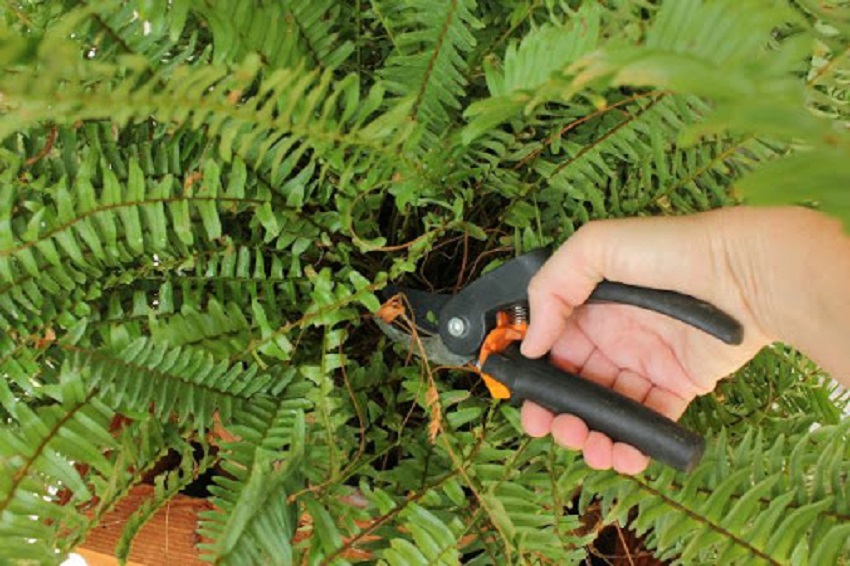
¿Cuáles son las enfermedades más comunes de los helechos?
Las plantas de helecho son, por desgracia, muy propensas a las enfermedades. Además, varias plagas también se interesan por ellos. Hay que tener cuidado y actuar inmediatamente, ya que cualquier retraso significa que podría ser demasiado tarde para salvar el helecho.
En cuanto a las enfermedades causadas por hongos, las manchas son las más comunes. ¿Qué hacer en este caso?
- Eliminar todas las hojas infectadas.
- Utiliza un producto especial contra la enfermedad - puedes encontrarlo en una tienda de jardinería o comprarlo online.
- Comprueba que el suelo de la planta no esté demasiado húmedo: esas condiciones son perfectas para los hongos.
Como ya hemos dicho, varios tipos de plagas son una gran amenaza para las plantas de helecho. Les gusta residir en las plantas sobre todo en verano, cuando la alta humedad y la temperatura crean condiciones favorables para ellas. A continuación encontrará las plagas más peligrosas:
- araña roja,
- escamas blandas,
- escamas acorazadas,
- colémbolos,
- gusanos redondos,
- ácaros.
Planta de helecho: ¿qué hay que saber antes de hacer la compra?
Al comprar un helecho y cualquier otra planta de interior, debe prestar atención a varias cuestiones, ya que afectan al crecimiento posterior de la planta.
En primer lugar, compruebe si el helecho no está demasiado seco y si no hay hojas marrones o plagas en las partes inferiores de las hojas. De esta forma, puedes estar seguro de que la nueva planta no dañará las plantas de interior que ya tienes.
Algunos expertos también sugieren buscar brotes jóvenes. Esto es señal de que la planta está en buen estado y crecerá rápidamente.


📍 ¿Por qué se está secando el helecho?
La planta de helecho se está secando porque la temperatura es demasiado alta. Tenga en cuenta que es uno de los muchos problemas posibles. El exceso de calcio que puede encontrarse en el agua o en el abono puede ser otro.
📍 ¿Cómo cuidar las plantas de helecho?
Las plantas de helecho deben contar con el tipo de suelo adecuado: debe ser rico y ácido. La temperatura moderada, la alta humedad y la fertilización regular sin calcio son otros factores importantes.
📍 ¿Por qué las hojas de mi helecho son marrones?
Las hojas marrones de los helechos pueden significar que la planta se está secando, pero no siempre. Otras posibles causas son una temperatura demasiado baja de la habitación en la que se ha colocado la planta. Una humedad demasiado alta -en el aire o en el suelo- es otra razón, así que asegúrate de observar cuidadosamente la planta de helecho y cualquier cambio en su aspecto.
📍 ¿Cómo regar una planta de helecho?
Los helechos son plantas amantes de la humedad, así que asegúrate de regarlos regularmente, al menos una vez a la semana. Necesitan un tratamiento especial en verano, cuando los días calurosos suponen una amenaza de daños. En este caso, la planta de helecho puede necesitar ser regada incluso 2-3 veces a la semana.
Artículos destacados




